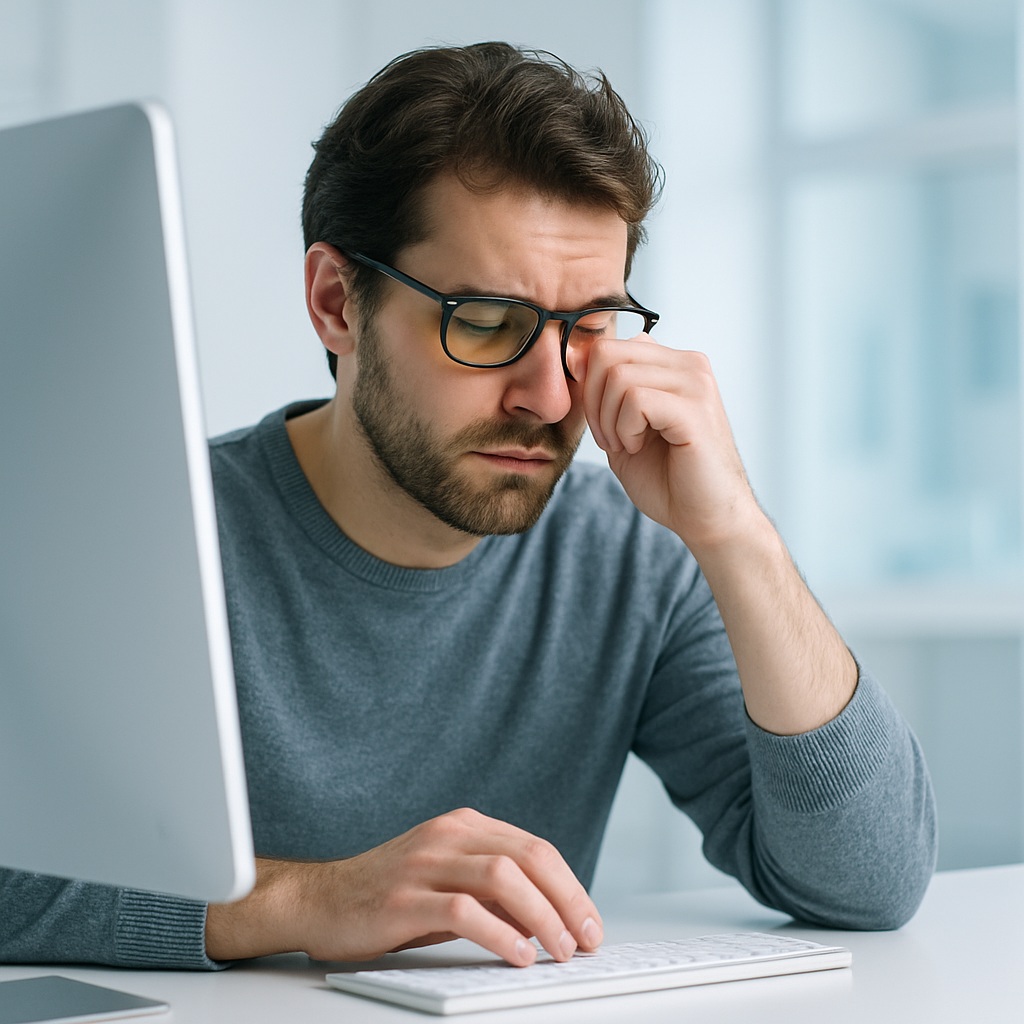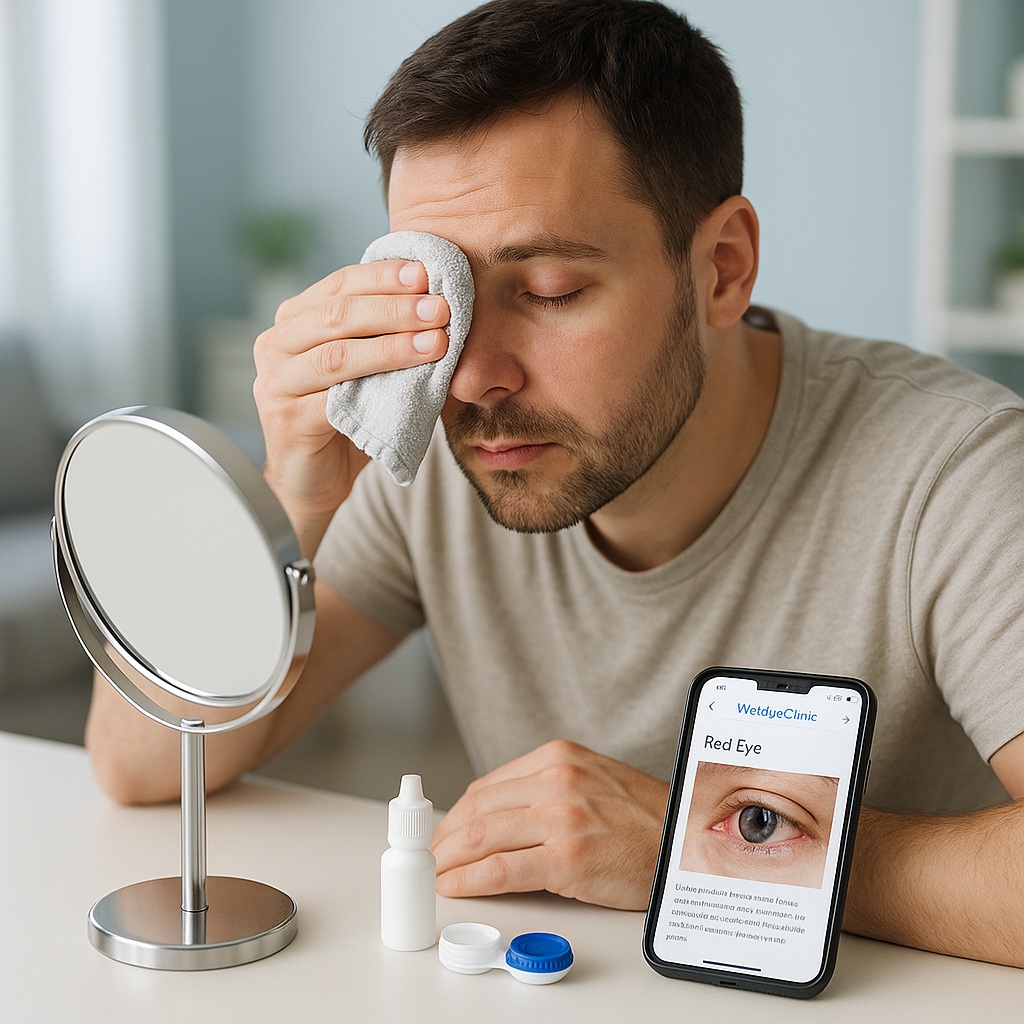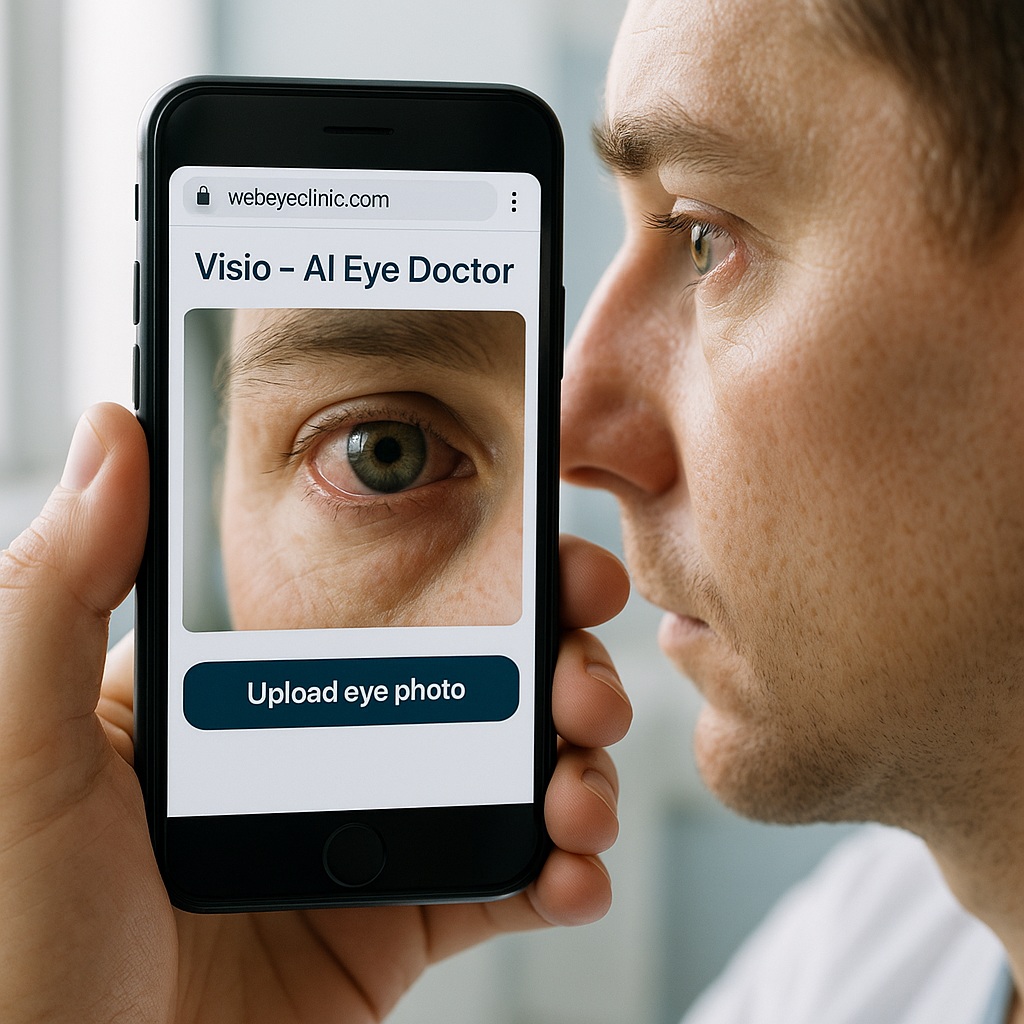Published: October 2025
This guide is for anyone dealing with eye strain from screens and was medically reviewed by an eye doctor. Before you spend money on “blue light” glasses, read this.
Do blue light glasses really help eye strain, or are they mostly marketing? People buy them hoping to fix burning eyes, tired eyes, headaches, trouble focusing, and even poor sleep. Blue light glasses are everywhere — pharmacies, Instagram ads, TikTok, even student “study hacks.” But large reviews of the evidence have found that blue light–filtering lenses do not reliably reduce digital eye strain symptoms compared to normal lenses, and there is no strong proof that blue light from screens is damaging your retina.:contentReference[oaicite:0]{index=0}
That doesn’t mean eye strain isn’t real. It is very real. Most adults now report some level of “screen fatigue,” and kids are getting it too.:contentReference[oaicite:1]{index=1} The real question is: are blue light glasses the solution — or is something else actually causing the problem?
First, What Is Digital Eye Strain?
Digital eye strain (also called “computer vision syndrome”) is the group of symptoms you feel after long screen time. Common symptoms include:
- Burning, sandy, or dry feeling in the eyes
- Tired or heavy eyes
- Blurry focus that comes and goes
- Headache or pressure around/behind the eyes
- Needing to blink hard or rub your eyes
Most of this strain is not from “blue light damage.” Eye doctors explain that the main cause is how we use screens: staring at one distance for a long time, barely blinking, keeping our eyes wide open under bright light, and holding phones too close.:contentReference[oaicite:2]{index=2} When you stare, your blink rate can drop to half or even one-third of normal. Less blinking = drier eyes = burning and blur.:contentReference[oaicite:3]{index=3}
So, a lot of “eye strain” is really dryness, muscle fatigue from constant near focus, glare, poor posture, poor lighting, and no breaks.
What Are Blue Light Glasses Supposed to Do?
Blue light is a high-energy part of visible light, and screens (phones, tablets, laptops, LED lighting) give off some blue wavelengths. Blue light glasses have a special coating or tint, often slightly yellow, designed to filter part of that blue light before it reaches your eyes.
The marketing promises usually include:
- Less eye strain
- Fewer headaches
- Protection from “blue light damage” to the retina
- Better sleep if you use screens at night
Here’s what research and major eye organizations say:
- Eye strain relief: Controlled studies and reviews of many smaller trials found little to no meaningful difference in reported eye strain between people wearing blue light–filtering lenses and those wearing regular clear lenses.:contentReference[oaicite:4]{index=4} In other words, many people felt the same either way.
- Retina protection: The amount of blue light from screens is tiny compared to sunlight. There’s no solid evidence that normal screen use causes retinal damage or macular degeneration, and the American Academy of Ophthalmology (AAO) says it does not recommend special “computer glasses” just to block blue light for eye safety.:contentReference[oaicite:5]{index=5}
- Headaches: Some individuals say they “feel better” with blue light glasses, but across groups, the improvement is inconsistent and often small.:contentReference[oaicite:6]{index=6} That suggests comfort may be personal, not guaranteed.
- Sleep: Blue light at night can interfere with melatonin and sleep timing. Some people report better sleep quality when they block blue light in the evening. But studies are mixed, and using “night mode” / warm screen settings + limiting late scrolling often helps just as much without buying glasses.:contentReference[oaicite:7]{index=7}
Short version: blue light glasses are not harmful, but for most people they are not a magic fix for digital eye strain.
If Blue Light Isn’t the Main Problem, Why Do My Eyes Hurt After Screens?
Let’s break down the big reasons your eyes feel awful after hours on a phone or monitor:
1. You blink less → your eyes dry out
When you concentrate, you blink less. Your natural tear film evaporates. The corneal surface dries. That causes stinging, burning, foreign-body sensation, and blurry vision that clears when you blink hard or use artificial tears.:contentReference[oaicite:8]{index=8}
2. Your focus muscles get tired
Your eyes have tiny muscles that constantly adjust to keep near objects clear. Staring at one fixed distance (for example, laptop at 40 cm) for hours overworks those muscles. You feel heaviness, forehead/eyebrow tension, and “I can’t keep this text steady anymore.” That’s fatigue, not blue light injury.:contentReference[oaicite:9]{index=9}
3. Your setup is bad
Glare on the screen, a monitor that’s too high, tiny font, air from AC blowing in your eyes, sitting too close — all of these force your eyes to work harder. Poor ergonomics = more strain.:contentReference[oaicite:10]{index=10}
4. You never take breaks
Breaks are not “laziness.” They’re literally eye maintenance. Eye doctors now teach the 20-20-20 rule: every 20 minutes, look at something about 20 feet away for at least 20 seconds. That forces your focus system to relax and reminds you to blink. Studies and clinical guidance show this simple habit can improve dryness, discomfort, and overall digital eye strain symptoms.:contentReference[oaicite:11]{index=11}
Some clinics even recommend a “10-10-10” version for heavy phone users: every 10 minutes, look 10 feet away for 10 seconds. The idea is the same — don’t lock your eyes in the same near position nonstop.:contentReference[oaicite:12]{index=12}
So, Should I Buy Blue Light Glasses?
Here’s the honest, current-position answer from eye care organizations and recent evidence:
- There is no strong evidence that blue light from screens permanently damages the eyes.:contentReference[oaicite:13]{index=13}
- There is no strong, consistent evidence that blue light glasses alone fix digital eye strain for most people.:contentReference[oaicite:14]{index=14}
- Some people personally report “it feels better” with a mild yellow-tinted lens, especially in harsh office lighting. Comfort is real. Placebo is also real. If they help you and they’re not overpriced, that’s okay.
- If you work late at night and have trouble sleeping, wearing blue-light–filtering glasses in the last 1–2 hours before bed might help your sleep rhythm — but so can dimming screens, using “night mode,” and actually stopping doomscrolling before bed.:contentReference[oaicite:15]{index=15}
In other words: buying blue light glasses is not dangerous, but don’t expect them to cure dry, burning, end-of-day screen eyes all by themselves.
What Actually Helps With Eye Strain (That Eye Doctors Recommend)
If your goal is to feel better at the end of the day, focus on habits that are proven to matter:
- Follow the 20-20-20 rule. Every 20 minutes, look 20 feet away for 20 seconds. Set a timer or use any “eye break” app. This reduces muscle fatigue and reminds you to blink.:contentReference[oaicite:16]{index=16}
- Lubricate. Use preservative-free artificial tears if your eyes burn or feel gritty. Dry surface = blurry, irritated vision.
- Fix your setup. Keep your screen about arm’s length away and slightly below eye level, so you’re looking a little downward (more natural, less exposed eye surface, less evaporation). Reduce glare. Increase font size so you’re not squinting.:contentReference[oaicite:17]{index=17}
- Don’t marathon in contact lenses. Over-worn lenses dry the cornea and can cause pain, blurred vision, and in severe cases corneal infection — which is an emergency, not “just eye strain.”:contentReference[oaicite:18]{index=18}
- Sleep. Fatigue makes focusing harder. Late-night scroll adds strain plus melatonin disruption. If you must use screens at night, use built-in “night shift” / “warm” modes or dimmer lighting instead of staring at bright white light in the dark.:contentReference[oaicite:19]{index=19}
- Get an actual eye exam. Sometimes “eye strain” is you squinting through an uncorrected prescription, early dryness, eyelid gland issues, or focusing problems. Those need real treatment, not a filter coating.:contentReference[oaicite:20]{index=20}
When It’s NOT Just Eye Strain
If you notice any of these, stop reading about blue light and get same-day in-person care:
- Sudden vision loss or a dark gray curtain in one eye (possible retinal detachment or eye stroke).
- Flashes of light and a shower of new floaters.
- A red, painful eye with halos, headache, and nausea (possible acute glaucoma or severe corneal problem).
- A white spot on the eye’s surface with severe light sensitivity (possible corneal ulcer, often in contact lens wearers).
Those are emergencies. Blue light glasses will not help those, and waiting can lead to permanent vision loss.:contentReference[oaicite:21]{index=21}
How WebEyeClinic Can Help
Still unsure if what you’re feeling is “normal strain” or “go now”? You can tell us what you’re feeling — burning, blur, headaches at the computer, trouble keeping one eye clear — using our Ask the Eye Doctor service. We’ll help you understand what might be happening, how urgent it sounds, and exactly which questions to ask when you see an eye doctor in person.
Start here:
Ask the Eye Doctor.
We can also help translate your symptoms into clear language for your clinic visit.
Bottom Line: Are Blue Light Glasses Worth It?
Blue light glasses are not “bad,” but most research so far says they are not a guaranteed fix for screen-related eye strain, and they are not proven to protect the retina from normal screen use.:contentReference[oaicite:22]{index=22} Some people like them for comfort, especially at night. That’s fine. But you should know the bigger wins are free: blink breaks (20-20-20), better ergonomics, artificial tears, and getting the right glasses prescription.
If you’re having true eye strain every day, don’t just buy another pair of “gaming blue blockers.” Get evaluated. Sometimes the problem is dryness, focusing fatigue, glare — or a real medical issue that needs treatment, not a filter.
Medically reviewed by: SR, MD, Ophthalmologist (Eye Specialist).
Last updated: October 25, 2025.


